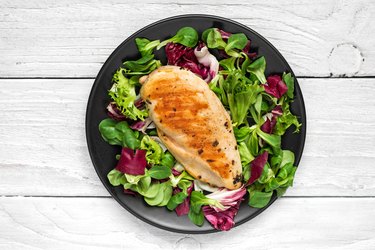
Gout is a type of arthritis that develops from excess uric acid in the body, according to the National Institute of Arthritis and Musculoskeletal and Skin Diseases. However, this painful condition can be improved with dietary changes. You can still eat chicken if you have gout, but you'll need to choose certain preparation methods and limit how much chicken you eat. Chicken, like all other types of poultry, meat, fish and shellfish, is a source of purines. Purines are broken down into uric acid in your body. If you eat too many purine-rich foods, excess uric acid can build up in your joints causing an increase in the frequency and severity of your gout symptoms. Your doctor or a dietitian can help you plan a balanced gout diet designed to help manage your condition.
High Purine Foods
Video of the Day
Foods with a moderately high concentration of purines have between 9 and 100 milligrams of the compounds in every 3-ounce serving. All cuts of chicken fall into this category, though some other types of poultry — goose, partridge and duck, for example — are high-purine foods with 100 to 1,000 milligrams of purine compounds in a 3-ounce serving and should be avoided. Chicken is similar in purine content to lean beef and pork, most types of fish, some shellfish, mushrooms, dried beans and asparagus.
Video of the Day
Chicken and Gout
The University of Pittsburgh Medical Center reports that gout patients can have up 6 ounces of protein-rich, moderately high-purine foods like chicken each day. Limit yourself to 2- or 3-ounce servings at a given meal. Drink 8 ounces of water before and after meals containing chicken, especially if you have gout or a history of kidney stones. Adequate fluid intake flushes uric acid out of your blood, helping to prevent the buildup of uric acid crystals in your joints. If your gout symptoms have recently worsened, eliminate chicken from your diet until your flare-up has resolved.
Best Cuts of Chicken
People with gout should keep their total fat intake to 30 percent or less of their daily calories. A diet higher in fat may exacerbate your symptoms since fat can prevent your kidneys from properly eliminating uric acid. For the leanest cuts of chicken, choose skinless breasts or extra-lean ground white meat. Choose less dark meat — thighs and drumsticks — which contain more fat per serving. If your sodium intake is also a concern, look for chicken that has not been flavor enhanced with a high-sodium saline solution.
Chicken Preparation Tips
Avoid breading and frying chicken to keep your fat intake low. Do not serve cooked chicken with high-fat cream sauces or rich gravies. The broth, bouillon and meat extracts often used to prepare gravy for chicken dishes are high-purine foods and should be avoided. Grill, broil, roast, stir-fry or poach chicken instead, using small amounts to add flavor to your meal instead of making a large portion the focus. Serve the chicken with carbohydrate-rich foods since carbohydrates help your body eliminate uric acid.